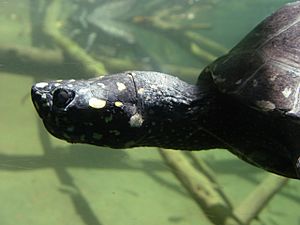Spotted pond turtle facts for kids
Quick facts for kids Spotted pond turtle |
|
|---|---|
 |
|
| Conservation status | |
| Scientific classification | |
| Kingdom: | |
| Phylum: | |
| Class: | |
| Order: | |
| Family: |
Geoemydidae
|
| Genus: |
Geoclemys
|
| Species: |
G. hamiltonii
|
| Binomial name | |
| Geoclemys hamiltonii (Gray, 1831)
|
|
| Synonyms | |
|
|
The Black Pond Turtle, also known as the Spotted Pond Turtle, is a cool reptile called Geoclemys hamiltonii. This turtle lives in the freshwater areas of South Asia. It's known for its striking black shell and skin, covered with bright yellow or cream-colored spots. These spots make it look unique and help it blend into its watery home.
Black Pond Turtles are mostly aquatic, meaning they spend most of their time in water. They are shy creatures and often hide among plants or rocks. They are an important part of their ecosystem. Sadly, their numbers are decreasing, and they are considered a vulnerable species. This means they need our help to survive in the wild.
Contents
Meet the Black Pond Turtle
The Black Pond Turtle is a medium-sized turtle. Its shell can grow up to 35 centimeters (about 14 inches) long. The shell is usually dark black or brownish-black. It has many small, round yellow spots all over it. These spots are also found on its head, neck, and legs. The spots can sometimes look like tiny stars against a dark sky.
This turtle has a strong, smooth shell. Its head is relatively small compared to its body. It has a pointed snout and strong jaws. Its feet are webbed, which helps it swim very well. The webbed feet are perfect for moving through water quickly.
Where They Live: Habitat
Black Pond Turtles live in freshwater environments. You can find them in slow-moving rivers, ponds, lakes, and swamps. They prefer areas with lots of aquatic plants. These plants provide good hiding spots. They also offer food and places to bask in the sun.
These turtles are found in several countries in South Asia. Their natural range includes India, Pakistan, Bangladesh, and Nepal. They like warm climates. They need access to both water and land. They use the land for basking and laying eggs.
What They Eat: Diet
Black Pond Turtles are omnivores. This means they eat both plants and animals. Their diet changes depending on their age and what's available. Young turtles often eat more insects and small aquatic creatures. Adult turtles tend to eat more plant material.
Their diet can include:
- Small fish
- Insects and their larvae
- Worms
- Snails and other small mollusks
- Aquatic plants
- Algae
They use their strong jaws to crush shells of snails. They also use them to tear apart plants.
Life and Behavior
Black Pond Turtles are mostly active during the day. They spend a lot of time swimming and foraging for food. They are also known to bask in the sun. Basking helps them regulate their body temperature. It also helps them absorb Vitamin D, which is important for their shell health.
When they bask, they often climb onto logs, rocks, or muddy banks. If they feel threatened, they quickly slide back into the water. They are quite shy and will hide if they sense danger. They are good at camouflaging themselves among the dark mud and plants.
Reproduction and Life Cycle
The reproduction of Black Pond Turtles usually happens in the warmer months. Female turtles lay their eggs on land. They dig a nest in soft soil or sand, often near the water's edge. A female can lay a clutch of about 5 to 10 eggs.
The eggs are white and oval-shaped. They are buried to protect them from predators. The incubation period, which is how long it takes for the eggs to hatch, depends on the temperature. It can take several weeks to a few months. Once hatched, the baby turtles are very small. They are miniature versions of their parents. They immediately head for the water to start their lives.
Young turtles grow quickly. They reach maturity in a few years. Black Pond Turtles can live for many years in the wild. Their lifespan can be over 20 years if conditions are good.
Protecting the Black Pond Turtle
The Black Pond Turtle is listed as "Vulnerable" by the International Union for Conservation of Nature (IUCN). This means their population is decreasing. They face several threats in their natural habitat.
Threats to Survival
- Habitat Loss: Their homes are being destroyed. Wetlands are drained for farming or building. Rivers are polluted.
- Pollution: Water pollution from human activities harms them. It can make them sick or reduce their food sources.
- Illegal Pet Trade: Some people illegally capture these turtles to sell them as pets. This removes turtles from the wild.
- Hunting: In some areas, they are hunted for food or traditional medicine.
Conservation Efforts
Many groups are working to protect the Black Pond Turtle. These efforts include:
- Protecting Habitats: Creating protected areas where turtles can live safely.
- Reducing Pollution: Working to clean up rivers and ponds.
- Stopping Illegal Trade: Enforcing laws against capturing and selling wild turtles.
- Raising Awareness: Educating people about the importance of these turtles. This helps people understand why they need protection.
By learning about these amazing creatures, we can all help protect them. Every effort helps ensure that the Black Pond Turtle continues to thrive in its natural home for future generations.


